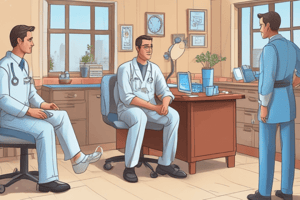Podcast
Questions and Answers
Which of the following is NOT recommended when documenting the intensity of pain?
Which of the following is NOT recommended when documenting the intensity of pain?
- Using a numerical rating scale (correct)
- Describing pain as mild, moderate, or severe
- Focusing on the impact of pain on activities of daily living
- Avoiding statements about the patient's condition
In the assessment section of documentation, what should primarily be included?
In the assessment section of documentation, what should primarily be included?
- Detailed descriptions of the patient's medical history
- Bullet points outlining the diagnosis (correct)
- Observations from the rehab
- List of all the diagnostics they have done
When documenting the patient's plan, what is important?
When documenting the patient's plan, what is important?
- Increasing the difficulty of exercises from session to session (correct)
- Maintaining the same level of exercise difficulty in sessions
- Assigning exercises unrelated to the patient's condition
- Focusing solely on patient comfort during therapy
Which activity should NOT be included in the subjective documentation?
Which activity should NOT be included in the subjective documentation?
If the patient asks something you don't know you should?
If the patient asks something you don't know you should?
In what scenario is it especially critical to summarize how a patient has been doing?
In what scenario is it especially critical to summarize how a patient has been doing?
What does the subjective part of the SOAP note focus on?
What does the subjective part of the SOAP note focus on?
What is a critical element to include in the subjective documentation other than the chief complaint?
What is a critical element to include in the subjective documentation other than the chief complaint?
What document should be referred to when creating the assessment section of patient notes?
What document should be referred to when creating the assessment section of patient notes?
Which section do you copy from the Diagnosis and plan or previous retest?
Which section do you copy from the Diagnosis and plan or previous retest?
What to do if a patient makes you uncomfortable?
What to do if a patient makes you uncomfortable?
If a patient wants to hangout outside of the office?
If a patient wants to hangout outside of the office?
What is one of the main purposes of the subjective?
What is one of the main purposes of the subjective?
What level should the volume be when speaking with patients?
What level should the volume be when speaking with patients?
What part of the SOAP note is the subjective component primarily based on?
What part of the SOAP note is the subjective component primarily based on?
What is a potential consequence of providing incorrect information to a patient?
What is a potential consequence of providing incorrect information to a patient?
What is a recommended way to respond to a complex question about brain exercises?
What is a recommended way to respond to a complex question about brain exercises?
What should be communicated to family members wishing to enter the outside room?
What should be communicated to family members wishing to enter the outside room?
In which situation might family members be granted access to the outside room?
In which situation might family members be granted access to the outside room?
Flashcards are hidden until you start studying
Study Notes
Patient Interaction Overview
- Consistent greeting script for all staff during initial visits ensures uniformity and professionalism.
- Greeting includes a salutation ("How are you doing?"), assessment of the patient's condition, a "You-We-I" statement regarding the treatment process, and invitation for questions before beginning treatment.
Handling Patient Questions
- Redirect patients to the doctor for questions that are uncertain or beyond staff knowledge to preserve trust.
- If confident in the answer, explain using clear and generalized information, emphasizing the importance of accuracy.
- Provide an example of how to handle questions effectively while encouraging consultation with the doctor for detailed responses.
Documentation: SOAP Method
-
Subjective: Focus on patient-reported symptoms and their effects on daily life, especially crucial for personal injury cases.
- Document chief complaints, intensity, and changes since the last visit without using numerical ratings.
- Describe how symptoms prevent patients from performing daily activities, ensuring to justify the necessity of care.
-
Objective: Record observations made by the provider, utilizing the "Pertinent Findings" from the Diagnosis and Plan chart.
-
Assessment: State the diagnosis by copying bullet points from the relevant Diagnosis section to maintain clarity and accuracy.
-
Plan: Outline specific treatments conducted during the therapy session. Ensure that exercises progressively increase in difficulty to adequately challenge the patient and facilitate improvement.
Patient Interaction Overview
- Consistent greeting script for all staff during initial visits ensures uniformity and professionalism.
- Greeting includes a salutation ("How are you doing?"), assessment of the patient's condition, a "You-We-I" statement regarding the treatment process, and invitation for questions before beginning treatment.
Handling Patient Questions
- Redirect patients to the doctor for questions that are uncertain or beyond staff knowledge to preserve trust.
- If confident in the answer, explain using clear and generalized information, emphasizing the importance of accuracy.
- Provide an example of how to handle questions effectively while encouraging consultation with the doctor for detailed responses.
Documentation: SOAP Method
-
Subjective: Focus on patient-reported symptoms and their effects on daily life, especially crucial for personal injury cases.
- Document chief complaints, intensity, and changes since the last visit without using numerical ratings.
- Describe how symptoms prevent patients from performing daily activities, ensuring to justify the necessity of care.
-
Objective: Record observations made by the provider, utilizing the "Pertinent Findings" from the Diagnosis and Plan chart.
-
Assessment: State the diagnosis by copying bullet points from the relevant Diagnosis section to maintain clarity and accuracy.
-
Plan: Outline specific treatments conducted during the therapy session. Ensure that exercises progressively increase in difficulty to adequately challenge the patient and facilitate improvement.
Patient Documentation Guidelines
- Documenting patient's symptoms is essential for justifying treatment.
- Chief complaint should include intensity and changes since last visit.
- Describe how pain impacts daily activities and what the patient cannot do.
- Classify pain without using numbers:
- Mild: 1-2/10
- Moderate: 3-5/10
- Severe: 6-10/10
- Focus documentation on Activities of Daily Living (ADL), pain perception, and impacts on life.
- Avoid vague statements; specifics are necessary to validate treatment need.
SOAP Note Structure
- Subjective: Patient-reported information during therapy; crucial for personal injury cases due to potential auditing.
- Objective: Documented observations; copy from the Diagnosis and Plan chart's Pertinent Findings.
- Assessment: Include diagnosis from the Diagnosis section in the Diagnosis and Plan chart.
- Plan: Outline specific treatments performed; emphasize progression in exercise difficulty across sessions.
Patient Interaction Protocol
- Initial Greeting: Consistent across staff; includes:
- Salutation: "How are you doing?"
- Assessment request: "What’s going on since the last visit?" while taking notes.
- You-We-I Statement: Affirm patient symptoms and assure effective treatment.
- Inquire about questions: "Any questions before we begin?"
- Commence treatment: "Ok, let’s begin."
Handling Patient Questions
- If unsure about an answer, direct patients to the doctor to maintain trust.
- For known answers, explain with clarity to avoid misinformation.
- Use reassuring language and examples related to the patient's condition.
- Highlight that exercises focus on the brain’s maps related to movement and environment.
Additional Considerations
- Maintain patient privacy; inform family members that the therapy area is typically restricted to patients only unless necessary.
Studying That Suits You
Use AI to generate personalized quizzes and flashcards to suit your learning preferences.




